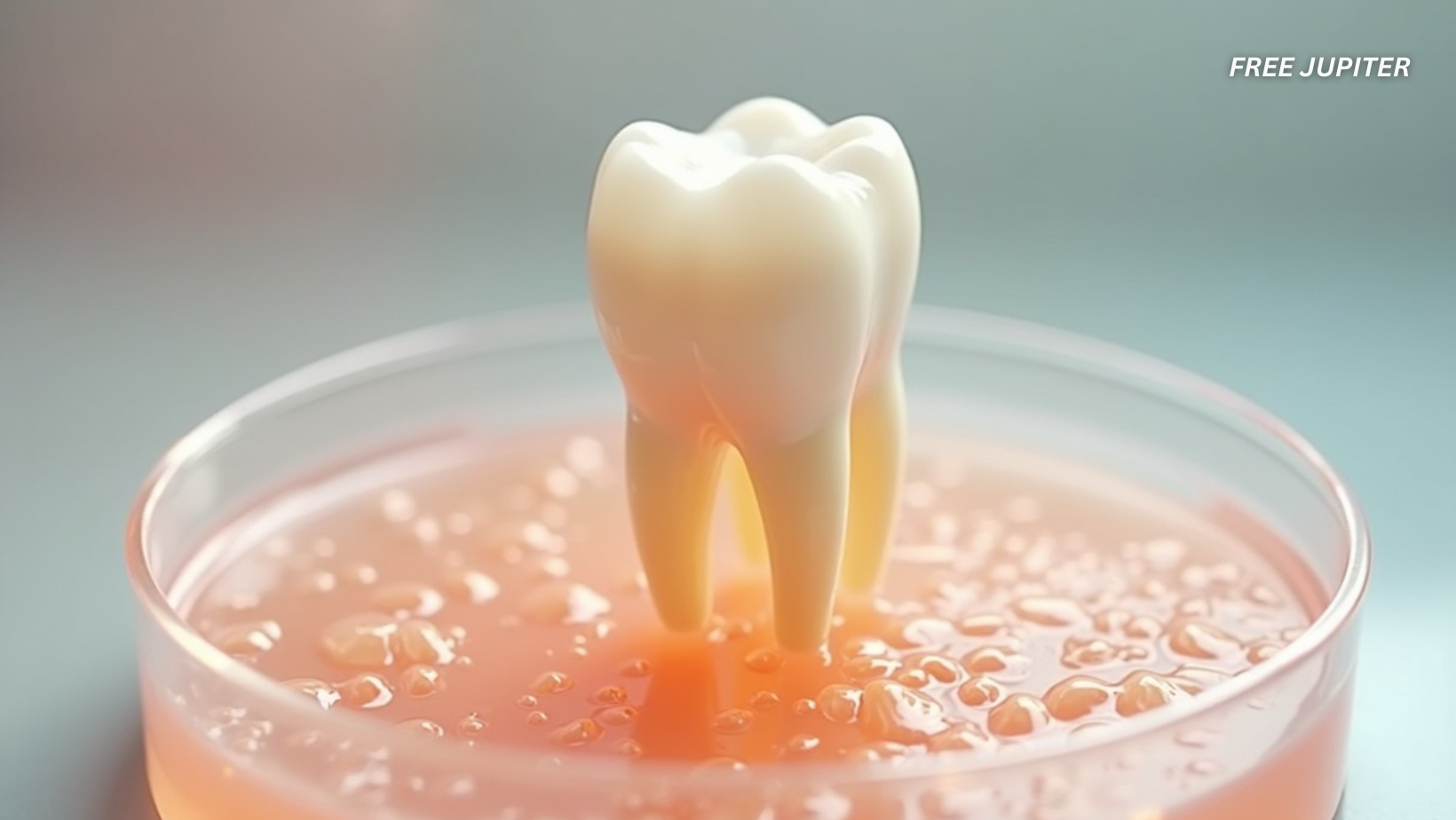Friendly Note: FreeJupiter.com shares general info for curious minds 🌟 Please fact-check all claims—and always check health matters with a professional 💙
Imagine a world where losing a tooth doesn’t mean living with an artificial substitute that never quite feels right. Instead, what if science could offer a replacement that not only looks natural but also feels and functions just like the original?
Researchers at Tufts University have taken a significant step toward making this vision a reality, unveiling a groundbreaking dental implant that grows into place, reconnects with nerves, and mimics the sensory experience of a genuine tooth.
Rethinking Dental Implants: Beyond the Basics
Traditional dental implants have long been the go-to solution for missing teeth. These devices typically involve a ceramic crown attached to a metal post, which is anchored into the jawbone.
While durable and effective in restoring appearance and basic function, these implants lack the subtle sensory feedback provided by real teeth. As a result, many people report that their implants never quite feel like a natural part of their mouth.
The main reason for this disconnect lies in the way natural teeth interact with the body. Real teeth are connected to the jawbone through a layer of soft tissue rich in nerves. This intricate network not only helps us sense pressure and texture but also plays a crucial role in guiding how we chew, bite, and even speak.
Conventional implants, however, bypass this soft tissue, anchoring directly into the bone and severing the natural nerve connections. This can lead to a sensation that is, at best, artificial, and at worst, uncomfortable.
The Science Behind the Smart Implant
Enter the new “smart” implant, a product of collaboration between Tufts University’s School of Dental Medicine and School of Medicine. This innovative device is designed to bridge the gap between artificial and natural teeth, both literally and figuratively.
At the heart of the smart implant is a biodegradable outer coating embedded with stem cells and a specialized protein. This protein acts as a signal, encouraging the stem cells to mature into nerve tissue. As the outer layer gradually dissolves, it releases these cells, which then integrate with the surrounding soft tissue and nerves in the gum.
Unlike traditional implants that require drilling into the bone, the smart implant is placed into the gum socket and secured by a layer of rubber nanofibers. These nanofibers expand as the biodegradable coating breaks down, anchoring the implant firmly within the soft tissue rather than the bone. Over time, the implant grows to fill the gap left by the missing tooth, creating a secure and natural-feeling fit.
A Softer, Gentler Approach
One of the most striking features of this new technology is its minimally invasive nature. Because the implant does not need to be anchored directly into the bone, the procedure is less traumatic and avoids many of the complications associated with traditional dental surgery.
There is no need for extensive drilling, reducing the risk of nerve damage and post-surgical discomfort.
Imaging studies have shown that, after placement, there is a clear space between the implant and the bone, indicating that the device is held in place by soft tissue rather than fused to the jaw.
This approach allows the implant to reconnect with nerves in the gum, reestablishing the crucial mouth-to-brain communication that is lost when a natural tooth is removed.
Read more: Chewing Gum Sets Off Microplastic Bombs In Your Mouth, Study Reveals
Restoring Sensation and Function
The ability to sense pressure, texture, and temperature is one of the defining features of natural teeth. These sensations not only enhance our enjoyment of food but also play a key role in protecting our teeth and guiding our chewing and speech.
By facilitating the regrowth of nerve tissue and integrating with the body’s sensory pathways, the smart implant aims to restore these subtle but vital functions.
“This new implant and minimally invasive technique should help reconnect nerves, allowing the implant to ‘talk’ to the brain much like a real tooth,” explained Jake Jinkun Chen, professor of periodontology at Tufts.
This breakthrough could have implications far beyond dentistry, potentially transforming the design of other bone implants, such as those used in hip replacements or fracture repair.
Early Success and Future Directions
While the smart implant is still in the early stages of development, initial trials in rodents have been promising. Six weeks after surgery, the implants were not only well-tolerated by the animals but also functioning much like natural teeth.
Researchers are now studying the animals’ brain activity to determine how effectively the new nerves are transmitting sensory information.
The next phase of research will involve testing the implant in larger animal models, followed by clinical trials in humans. If successful, this technology could revolutionize the field of dental medicine, offering a new standard of care for millions of people who lose teeth each year.
Read more: ‘Spiritual Bliss Attractor’: Strange Phenomenon Emerges When Two AIs Are Left Talking To Eachother
The Quest to Regrow Teeth
Efforts to regenerate lost teeth have long been a focus of dental research. While there have been some advances in bone regeneration, particularly in Japan, scientists have yet to develop a method that enables humans to grow entirely new teeth to replace those that are missing or extracted.
The smart implant represents a significant leap forward, offering a solution that not only replaces the physical structure of a tooth but also restores its sensory and functional roles.
What Sets This Implant Apart?
Let’s take a closer look at how this smart implant compares to traditional options:
| Feature | Traditional Implant | Smart Implant (Bioengineered Tooth) |
|---|---|---|
| Placement | Drilled into jawbone | Inserted into gum socket |
| Sensory Feedback | Lacks nerve connection | Reconnects with nerves, restores sensation |
| Surgical Procedure | Invasive, bone drilling | Minimally invasive, no bone drilling |
| Integration | Fuses with bone | Anchored by soft tissue, grows into place |
| Healing and Recovery | Risk of trauma, discomfort | Gentler, less risk of nerve damage |
| Long-term Functionality | Feels artificial | Mimics natural tooth function and feel |
Broader Implications for Medicine
The principles behind the smart implant could extend well beyond dentistry. By demonstrating that it is possible to engineer implants that integrate with nerves and soft tissues, researchers are opening the door to new approaches in orthopedic and reconstructive surgery.
Imagine hip or knee replacements that not only restore movement but also provide natural feedback, improving balance and coordination.
Challenges and Next Steps
While the early results are encouraging, several challenges remain before this technology can be widely adopted. Researchers must ensure that the implant is safe, durable, and effective across a diverse range of patients.
Long-term studies will be needed to assess how well the implant holds up over time and whether it can reliably maintain its connection with the body’s sensory systems.
There is also the question of cost and accessibility. As with any new medical technology, it will be important to ensure that the benefits of the smart implant are available to as many people as possible, not just a privileged few.
Read more: Aging Has Been Found To Occur In Three Stages: 34, 60, and 78, Study Shows
Looking Ahead: A Toothsome Future
The development of a bioengineered tooth that grows into place and feels like the real thing marks a turning point in dental science. By combining advances in stem cell biology, biomaterials, and tissue engineering, researchers are moving closer to a future where tooth loss no longer means compromising on comfort or function.
For now, the smart implant remains a work in progress, but its potential is undeniable.
As research continues, we may soon find ourselves in a world where artificial teeth are virtually indistinguishable from the originals they replace—restoring not just smiles, but the full sensory experience that makes eating, speaking, and living so richly human.
In the meantime, this innovative approach to tooth replacement is sure to inspire both scientists and patients alike, offering a glimpse of a future where technology and biology work hand in hand to improve our quality of life.
Disclaimer: The information in this article is for general informational purposes only and is not medical advice. We are not doctors, and this website is run as a family hobby project. Always consult a qualified healthcare professional before making decisions about your health. Please fact-check any claims and use this content as a starting point, not a substitute for professional guidance.










